Blog
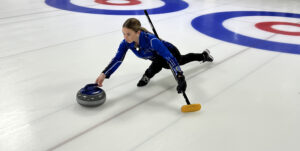
Toe-slide versus flat-foot slide: what is better for the athlete?
Perhaps there is no other sport that causes unilateral, repetitive strain injuries more than curling. A 2004 study of competitive players competing in two USA National events found a high incidence of back, knee, hip, wrist, and shoulder injuries amongst competitors of both genders: Sweeping the stone (55%) and delivering the stone (50%) were the skills most provocative of symptoms (fig 2A–C). Collectively, symptoms of knee (54%), back (33%), and shoulder pain (20%) were most prevalent (table 2). Knee pain was most often reported in the ‘‘tuck’’ knee, which is typically flexed well beyond 90˚ during stone delivery. Sixty-two per cent of those with knee pain were symptomatic in their tuck [slide foot] knee, while 31% complained of bilateral discomfort. Reeser and Berg, September 2004 Our intent in writing this article was two-fold: one, to make other coaches aware of the prevalence of anterior knee pain in youth curling, particularly with young women, and two, to recommend that athletes who
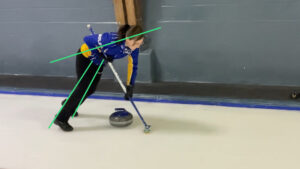
Brushing video analysis with OnForm
While an instrumented brush is ideal for capturing the force profile of an athlete, video analysis is equally essential so that the athlete can get visual feedback on their technique, and know if they have made the correct and desirable adjustments to their technique on subsequent bouts. In this article, I’m going to use Celeste Gauthier, of Team Émilie Lovitt and Toronto Metropolitan University, as a model to describe some useful tips in video analysis of brushing. What is OnForm? OnForm (formerly Hudl Technique) is a coaching application that supports recording and playback of video along with the ability to annotate video with diagramming or audio overlay to provide coach feedback. Videos are stored in the cloud (instead of on your device) and can be shared with athletes (or other coaches) on a coach license. In addition, OnForm now supports multi-camera inputs so one can capture simultaneous video from different camera angles, similar to other apps such as Switcher Studio.

No-tick rule now part of Curling Canada’s Rules of Curling for General Play
Following the adoption of the no-tick rule for competitive events in 2023-2024, Curling Canada has recently announced that the no-tick rule will also be incorporated into curling’s Rules for General Play. The change means that the no-tick rule is now (optionally) a part of the game, unless specific leagues or competitions decline to adopt the rule for their specific events. Note that the rule change does not impact the rules for mixed doubles, nor the rules for Wheelchair curling.
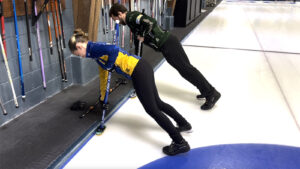
What is deliberate practice in curling?
In recent years the decline in participation in youth curling has led to a number of challenges in a variety of areas, from team formation, to event management, to coaching. In Ontario, as one example, the drop in participation of U20 teams has been nothing short of catastrophic. In 1990, 192 junior men’s teams entered zone playdowns for the Ontario Curling Association, where two zone representatives from each of the 16 competition zones in southern Ontario would earn the right to compete at four regional championships, with the winners and runners-up from those regional competitions going on to compete at the Provincial championship. Today, southern Ontario’s zone and regional competitions have vanished, replaced with one (sometimes two) qualifiers which may have teams advance to the provincial championship after playing just one or two games. In the past two seasons (2022-2023 and 2023-2024) the total number of junior men’s entries has been under 15 teams, with approximately half of those teams
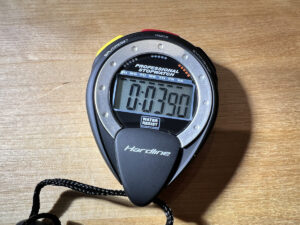
Ten reasons why an interval time might be inaccurate
This article is joint work with John Newhook of Dalhousie University in Halifax. Using interval, or “split” times, can benefit the delivering team because an interval time provides a proxy measurement for the velocity of the stone at release. With an interval time, the two brushers can utilize the time to assist with their weight judgement, and the delivering player can use a split time to assist their delivery with respect to weight control. However, relying on splits – either back-line to near hog line or, less commonly, tee-line to near hog line – can be complicated. One complication is that, to be more effective, the team must map split times into other timing systems, such as hog-to-hog times or hog-to-far tee-line times if they are to utilize the throws of the opposition team to help judge the speed of the ice. But the mapping of split times is by far not the only complication in their use. In this
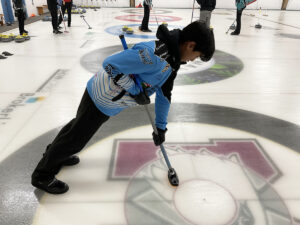
Does handedness matter in brushing?
Functional laterality – that is, handedness, footedness, and ocular dominance, are important physical characteristics in many team sports, such as ice hockey and baseball, or in racquet sports such as tennis, squash, and badminton. Handedness is often less of an issue in other sports, particularly individual sports, such as darts, or golf. Handedness, in particular, has been studied extensively [1,2]. Handedness refers to an individual’s preferential use of one hand over the other due to strength, quickness, or dexterity. The preferential hand is commonly referred to as the dominant hand. About 10% of the human population is left-handed, though this proportion does vary slightly by gender (males 10.5%, females 8.7%) [1,2], with 1% of the population being ambidextrous, having an equal ability with both hands. Taylor Stremick of Team Ashley Thevenot of Saskatoon being tested on a CurlSmart instrumented brush at the Sutherland Curling Club. To a significant degree, in many sports the advantage for a left-handed athlete is simply